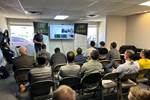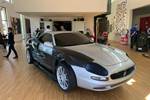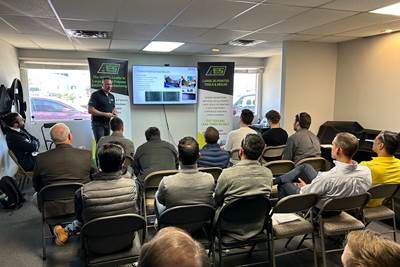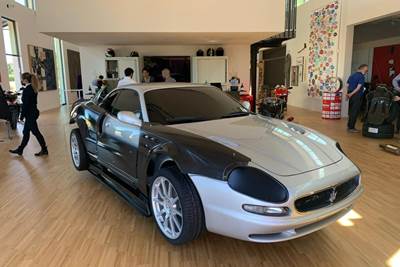Avoiding pitfalls in the design of LFAM composite components
Recoat temperature, part orientation and bead geometry are some key design variables to consider for a successful and reliable large-format additive manufacturing (LFAM) process.
A layer-to-layer delamination of beads from a print that was recoated too cold. Source (All Images) | Additive Engineering Solutions (AES)
Over the last 4 years, large-format additive manufacturing (LFAM) has matured from a curious technological approach to a robust and reliable form of manufacturing. LFAM consists of 3D printing parts using pellet feedstock at deposition rates of 25+ pounds per hour, resulting in large parts weighing hundreds, and sometimes thousands, of pounds each. The pellet feedstocks for this process are often thermoplastic composites consisting of a thermoplastic resin with short carbon or glass fibers.
Proven success within materials, equipment and printing providers have resulted in wider and more robust adoption of the technology. Collaboration between industry firms such as Airtech, CEAD, SABIC, Thermwood and Additive Engineering Solutions (AES) have further propelled its adoption and acceptance. As more successful projects are completed, awareness grows, and more companies are exploring how LFAM can help them achieve cost, quality and lead time objectives. Unfortunately, the first roadblock that new and prospective users of the technology encounter is the lack of documented design guidelines that could enable them to make the most efficient use of the technology. Developing an effective LFAM design and manufacturing strategy is critical to further success of industry participants.
Bead geometry selection
Historically, design for additive manufacturing (AM) has not been as important for fused deposition modeling (FDM) as it has been for other types of AM. Users of desktop FDM machines, both consumer and professional, are generally able to design a part in CAD as specifications dictate with the expectation that the design could be programmed (aka “sliced”) and printed on a 3D printer. Part of this reasonable expectation is due to the minuscule bead size and layers produced by these small-scale machines compared to the parts typically produced. In this scenario, the user selects the desired number of perimeter beads and infill settings while the slicing program outputs a dense maze of tool paths for beads that are typically 0.016-inch wide and 0.006-inch tall. With beads this size, the part can usually be printed without modification.
With LFAM, bead sizes can range from 0.25-1 inch in width and from 0.050-0.25 inch in thickness, with a typical bead being 0.75-inch wide × 0.2-inch thick. This bead is approximately 1,500 times the cross-sectional area of a traditional FDM bead, and where the traditional FDM is typically unfilled thermoplastic, the LFAM bead is a fiber-reinforced thermoplastic composite. This resulting bead is also much larger in relation to the geometry that is being printed. Due to this relationship, it is imperative to determine the bead geometry that will be used in manufacturing prior to commencing the design, as the bead geometry will dictate variables such as achievable wall thickness.
For example, consider a part designed to have 2-inch-wide walls but is meant to be printed with 0.75-inch-wide × 0.2-inch-tall beads. When this design is processed through a typical LFAM slicer, it will generate a two-bead-wide path, but there will be a 0.5-inch void between the beads. This void happens as a result of the wall being designed wider than two beads but narrower than three beads. In this case, if the designer knows that a 0.75-inch-wide bead is going to be used, the wall should either be reduced to 1.5 inches thick (two bead widths), upsized to 2.25 inches (three bead widths) or a discussion with manufacturing about changing the bead width employed to be a multiple of the desired wall thickness is necessary.
One area where there is some overlap between traditional FDM design and LFAM design is through the use of self-supporting angles. Similar to traditional FDM, it is possible to print self-supporting angles up to 45° with most bead sizes. If a design requires a more shallow support angle, then it may be achievable by using beads with a larger width-to-thickness ratio. This will be important to note when settling on a bead size for the design.
Slicing, orientation and supports
Another set of topics that must be considered during the LFAM design process is slicing strategy, bed orientation and the use of supports on printed models. Traditional FDM theory often allows various acceptable orientations in which to print a part. These orientations are enabled by the generous use of automatically generated and placed support structures that are easily broken away by hand or dissolved in liquid. Such support structure generation in LFAM is largely absent and would not be practical to implement in nearly all circumstances (unless maybe you had access to a pool to dissolve your support structure). The lack of support structures makes it difficult or impossible to have large, unsupported overhang features. Consequently, these parts must be designed to be largely self-supporting, often employing the self-supporting angles described previously.
In addition, many parts that would traditionally use support structures can be oriented on the build platform in ways that make the critical geometry self-supporting. This often results in non-traditional build orientations but enables the printing of critical features. One challenge that results from these orientations is an offset center of gravity that may be enough to tip a part over during the printing process. In these scenarios, designers may choose to add a simple support structure, something akin to a kickstand, that would help brace the part throughout the print.
Another feature of LFAM that enables designers to print otherwise unruly geometry is the use of angled slice planes. If we consider traditional FDM printers to have a “horizontal slice plane,” — a slice plane parallel to the flat build plate — angled slice planes rotate the slice plane to some angle, typically 45° from the traditional horizontal plane. As mentioned earlier, LFAM is often limited to 45° self-supporting angles. By rotating the build plane to 45° and incorporating a 45° overhang, designers can incorporate full 90° (perpendicular) features in their design.
The simplest way to envision this is to consider a standard six-sided hollow box geometry. Using traditional horizontal printing, it would be possible to print the bottom and the four side walls. However, the top of the box would pose an issue because it would be an unsupported surface where the deposited resin would simply fall to the bottom of the printed box. If the same geometry was sliced with a 45º slice plane, both the vertical walls and the top and bottom surfaces would simply be 45° overhangs from the nominal slice plane and the hollow six-sided box now becomes printable.
Thermal management
One final factor that can influence the success or failure of an LFAM print is the level to which key thermal management factors, such as layer recoat temperature, are managed. This leads to a particular “Goldilocks” effect with LFAM printing where the temperature of the previously deposited layer — often referred to as the recoat temperature — must neither be too hot nor too cold. If the recoat temperature is too hot, it is likely that the part will, at best, slump and deform during printing, or worse, completely fail during the build. If the recoat temperature is too low, the layer-to-layer bond strength will be compromised and depending on the severity of the cold recoat, the part could experience delamination between beads.
To further complicate thermal management, each thermoplastic composite has its own unique window of recoat temperatures. Typically, minimum recoat temperature is equivalent to the glass transition temperature (Tg) of the thermoplastic composite. In order to effectively manage the recoat temperature, it is highly recommended that a thermal camera be used to provide real-time feedback and to record the thermal history of the part should it be needed later for analysis. This thermal feedback can be critical to adjusting the part while printing.
Shown here is an example readout from a thermal camera, which enables AES to measure and manage recoat temperatures.
The need for effective thermal management can pose a challenge to composite part design as the thermal camera data can only be known once the design is finished, the part is sliced and printing has commenced. This is one area where experience with LFAM really counts. In the absence of experience, it may be advisable to run short printing tests of 10-20 layers early in the design process to measure the thermal characteristic of a particular geometry. That data can be invaluable for refining the design. Thermal management is another reason to also settle on bead geometry early in the design because larger beads tend to retain more heat and cool slower than smaller beads. Finally, it is important to try to maintain consistent thicknesses of printed walls on each layer. For example, if a tool is designed using a 0.75-inch-wide × 0.2-inch-thick bead and the face sheet of the tool is designed to be 3 inches wide (four beads wide), but the backup structure is designed as a single bead width, the part would experience vastly differentiated cooling rates between the four-bead wall and the single-bead wall and could be very difficult to manufacture.
Ultimately, the range of acceptable recoat temperature for a particular material and bead size will dictate the maximum and minimum size of the part that can be successfully designed and printed.
Eye on the end goal
When designing for LFAM, it is important to have the end goal of the design in mind, and then work backwards, considering key design variables such as recoat temperature, part orientation and bead geometry. When these items are considered before the actual CAD design is completed, the chance of success with LFAM is much greater.
About the Author
Austin Schmidt
Austin Schmidt is the co-founder and president of Additive Engineering Solutions (AES, Akron, Ohio, U.S.). Schmidt co-founded AES to commercialize large-format additive manufacturing (LFAM) and established the company to offer LFAM as a contract service. At AES, Schmidt works with customers to develop tools and applications that take advantage of LFAM. He has spoken on the topic at numerous industry conferences including RAPID, SAMPE and CAMX. Prior to founding AES, Schmidt spent 5 years in Caterpillar’s Engineering Leadership program. He has a bachelor’s degree in mechanical engineering from Case Western Reserve University. austin@additiveeng.com
Related Content
Reinforcing hollow, 3D printed parts with continuous fiber composites
Spanish startup Reinforce3D’s continuous fiber injection process (CFIP) involves injection of fibers and liquid resin into hollow parts made from any material. Potential applications include sporting goods, aerospace and automotive components, and more.
Read MoreOptimizing a thermoplastic composite helicopter door hinge
9T Labs used Additive Fusion Technology to iterate CFRTP designs, fully exploit continuous fiber printing and outperform stainless steel and black metal designs in failure load and weight.
Read MoreA new era for ceramic matrix composites
CMC is expanding, with new fiber production in Europe, faster processes and higher temperature materials enabling applications for industry, hypersonics and New Space.
Read MoreIndustrializing additive manufacturing in the defense/aerospace sector
GA-ASI demonstrates a path forward for the use of additive technologies for composite tooling, flight-qualified parts.
Read MoreRead Next
CEAD, AES kick off U.S. symposium highlighting LFAM ecosystem
CEAD Flexbot print cell demonstrations and industry presentations showcased the emerging options in 3D printing for polymers, composites and more at AES’ Akron facility.
Read MoreIndustrializing additive manufacturing in the defense/aerospace sector
GA-ASI demonstrates a path forward for the use of additive technologies for composite tooling, flight-qualified parts.
Read MoreHybrid 3D printing/machining center enables custom vehicle restoration project
3D-printed CF-filled molds made with new CMS Kreator system shorten production time, reduce costs for Bercella’s Restomod Maserati project.
Read More



























